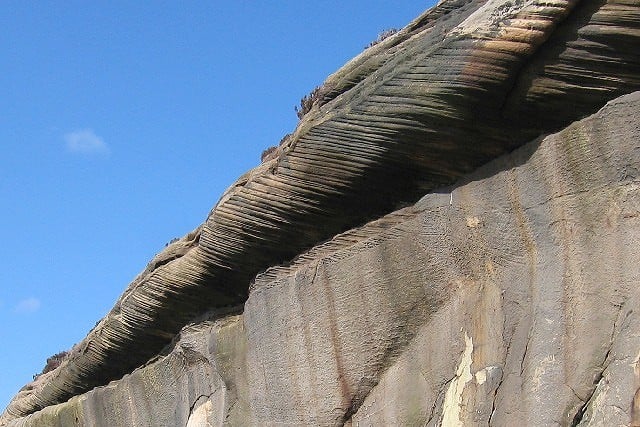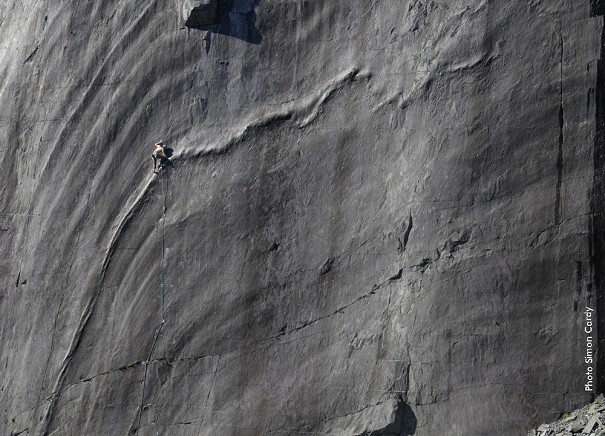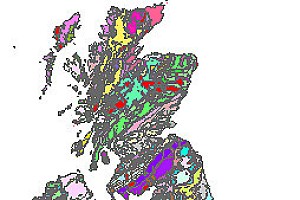
In this three-part series, Pete Reynolds AKA 'The Lakeland Rock Doctor' takes us on a tour of the varied and interesting rocks of the British Isles upon which we love (or occasionally hate) to climb...
In this second article in a series of three, we examine the life and death of sedimentary rocks - those formed by the consolidation of sediment on the Earth's surface. The sediments are the eroded pieces of another rock, or as we shall see, remnants of plant or animal life. Whilst these rocks make up the bread and butter of a British climber's diet, not all sedimentary rocks make for good climbing.

(Fig.1, above: This feature is characteristic of ripple formation. Here, the stratification results from rivers depositing sand along its bed. At the time this river was flowing, Britain was located on the equator and was busy making the coal that powered the Industrial Revolution.)
For instance, the southeast and the home counties are largely a rock climber's desert (southern sandstone excepted). The clays and till found in these parts of the country don't make good crags, or even any crags at all. But amongst all the choss and grime, the gritstone stands proud. For dragging, slapping and smearing your way up compacted detritus is an unfathomably popular way for climbers to spend their weekend. And so the Peak District and its edges of millstone grit are arguably the hub of British climbing, and convey our ethics to the world.
But what is it that makes climbing on the grit so bold? To understand this, we need to know why and how gear-taking cracks appear in the first place. In some instances, the cracks form way after the rocks were deposited. Immense tectonic forces and the groaning and grinding of tectonic plates has caused the rocks to fail and crack. The splitters at Indian Creek in the US are a prime example of this. In other cases, cracks represent an original feature in the rock that has been exaggerated by weathering. Such is the case in gritstone. Imagine a river like the Ganges that has been flowing for millions of years. The river is continually depositing sediment. However, over time the type of sediment and rate at which it is deposited changes. And so the vertical sequence of sediment that accumulates changes.
Abrupt variations in the type of sediment can lead to natural weaknesses forming in the rock. When these abrupt changes are exposed at the Earth's surface, they weather more easily than the surrounding sequences. And so horizontal breaks are born, ready to take cams, whilst the over- and underlying sequence of sediment is bullet hard and blank. Our favoured gritstone edges are therefore the result of sustained periods of deposition from an ancient river. In reality of course it's a mixture of both tectonic forces and changes in sediment deposition that form gear placements, but changes in sediment deposition are the most interesting to observe.
Other features related to how the sediment was deposited can be easily spotted. Look out for "wavy lines" or layers – what you're seeing here are cross sections of ancient ripples. In some cases, more so in sandstones, you get to see these ripples from above (hunt at the top of the crag or inside the breaks). They'll look just like ripples on a river bed or beach – just a few tens of millions of years older. Other clues to changes in sediment deposition include layers particularly rich in pebbles, formed as the river experienced particularly high flow and was able to transport larger pieces of sediment.
I invite you, on your next grit session, to look closely at that pebble you might think of wrapping a thumb round. That isn't a crystal (that term is largely reserved for the components of igneous rocks – see our previous article). Instead, the pebbles and grains of sand are from an ancient mountain belt that was gradually eroded and transported towards the sea. Some grains are noticeably rounded – this is a telltale sign of abrasion, as the grains of sand and pebbles are rubbed against each other during transport. You can hear this process of abrasion occurring on a beach, just listen for the rattle as the waves recede. In contrast, some grains remain angular, indicating lesser transport distances. So we see that the distance that sediment is transported, from source (ancient mountains) to sink (an ancient sea) plays an important role in tearing up the rubber on your rock boots, or determining how long your tips survive.
But what is it that differentiates gritstone from its cousin, the (relatively) smooth and friendly sandstone? Note that sandstones (such as those found in Northumberland) tend to be composed of grains all of the same mineral and size. In contrast, gritstone is formed of a wide variety of grains, with different sizes, shapes and mineral compositions. It is this variety of shapes and sizes, as well as the cement (the rock-glue holding the grains together) that give gritstone its characteristic texture. Therefore slopers would not be slopers without a shake of different minerals followed by a good squashing and gentle baking (these processes occur at shallow depths, and allow the cement to form).
No discussion of sedimentary rocks would be complete without a look at limestone; that which is found from the south coast of England, through Wales, the Dales and into the central belt of Scotland. Limestone is basically a graveyard. It's made of loads of tiny fossils, some small, some not so small, as well as the relicts of a giant seafood banquet. But you don't have to go outside to get an idea of what these fossils look like. Next time you're at the wall look out for the giant ammonite climbing hold – it looks like a spiral shell. These creatures were basically a squid living inside a shell. They died out before resin was invented, but yet were around for 140 million years. They will most likely do a longer stint on the planet than we will. Our testament to their durability and our own stupidity is smothering them in chalk and standing on them.
In addition to being composed of dead stuff, limestone has a handy habit of dissolving nicely in slightly acidic rain water. And this, by way of eventual precipitation, leads to the formation of limestone's most curious and charming feature – tufa. First, remember that the dissolving and precipitation is all happening underground. By this stage the limestone has already been formed, and it's now being eroded by rain water that has found its way underground (check out the river at the base of Malham Cove for an example). The rainwater has first dissolved some of the limestone, and has carried it along in solution (like salty water). As the temperature of the water changes, or as it becomes saturated with limestone, it precipitates the carbonate back out. This precipitate builds up to form tufa. Of course, the crucial thing here is that when the carbonate is precipitated it keeps happening again and again in the same place. So think of how you get the wet streaks at the crag – they form those notorious routes to avoid in winter. It's those wet streaks, underground, where the carbonate is continually deposited. And if you get a continual drip from a cave ceiling, then you start to build stalactites and stalacmites. More cool stuff to climb on.
(Fig.3, above: These are like the preserved footprints of some ancient creepy crawly. Look out for similar features at the tops of sandstone crags.)
Sedimentary rocks all eventually suffer one of several fates. They might be quarried and turned into something useful, like building stone or a corn grinder. Or they might just stand there, staring across the moors in the rain, waiting to be eroded and turned into another sedimentary rock. But perhaps their most glamorous fate is to be shoved beneath the Earth's surface. Here, deep down, the sediments are changed beyond recognition, altering their chemistry, destroying their fabrics and providing them with a completely new set of characteristics. They then are reborn as metamorphic rocks – the topic of the final article.











Comments
Thought this would be a boring read but actually quite enjoying this mini series.
Great article, really enjoyed it, thanks
A good quick overview, but
"without a look at limestone; that which is found from the south coast of England, through Wales, the Dales and into the central belt of Scotland"
should go on to add
...and then on to Skye & the far NW (eg Durness limestone)
yes and via Ballachullish...
I was hoping this was going to be an exciting read, however I was dismayed by the lack of detail that the author conveyed about about the formation of these sedimentary rocks, the processes responsible for their deposition (ripple strata are not the same as cross strata), and what make the Millstone Grit different from the Fell sandstone (pictured in figure 1) or from some other (clastic) sedimentary rocks, like the Chester Formation.
What are these abrupt variations in sediment type? If you look at figure 1 in the article, both the cross strata and the underlying "stuff" are composed of sandstone, so why are these two layers different? Were both of these sandstones deposited in a river, under the same conditions? If you look at a modern river, and the surrounding flood plains, you will notice that the flood plains cover a much larger area than the river. Why don't we see any layers of these mudrocks at many crags? For example, Hen Cloud is ~35m tall, and exposes no mudstones. Why?
I appreciate that someone is making an attempt to describe the geology of Britain from a climbers perspective, but to do the subject justice would require much more detail, and explanation to the causes.
Maybe focus on questions which are universal to many sandstone crags like "What forms these diagonal layers in these sandstones which i am climbing on?", or "Why is the sandstone here coarse, gravelly and ripping my skin, while up there, the sand is finer, and doesn't hurt as much?", or "why is Stanage edge grey-ish, the roaches red/orange-ish, and Ousal crack in Churnet valley propper red?".